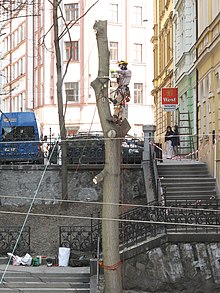
Arboriculture is the cultivation, management, and study of individual trees, shrubs, vines, and other perennial woody plants. The science of arboriculture studies how these plants grow and respond to cultural practices and to their environment. The practice of arboriculture includes cultural techniques such as selection, planting, training, fertilization, pest and pathogen control, pruning, shaping, and removal.

An arborist, tree surgeon, or arboriculturist, is a professional in the practice of arboriculture, which is the cultivation, management, and study of individual trees, shrubs, vines, and other perennial woody plants in dendrology and horticulture.
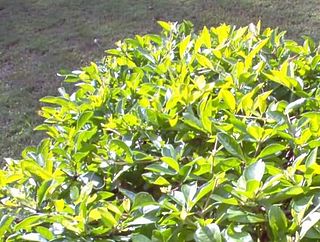
Pruning is a horticultural, arboricultural, and silvicultural practice involving the selective removal of certain parts of a plant, such as branches, buds, or roots.

Urban forestry is the care and management of single trees and tree populations in urban settings for the purpose of improving the urban environment. Urban forestry involves both planning and management, including the programming of care and maintenance operations of the urban forest. Urban forestry advocates the role of trees as a critical part of the urban infrastructure. Urban foresters plant and maintain trees, support appropriate tree and forest preservation, conduct research and promote the many benefits trees provide. Urban forestry is practiced by municipal and commercial arborists, municipal and utility foresters, environmental policymakers, city planners, consultants, educators, researchers and community activists.
Articles on forestry topics include:.

Alex L. Shigo was a biologist, plant pathologist with the United States Forest Service whose studies of tree decay resulted in many improvements to standard arboricultural practices. He travelled and lectured widely to promote understanding of tree biology among arborists and foresters. His large body of primary research serves as a broad foundation for further research in tree biology.
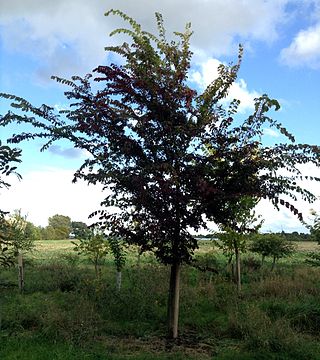
Ulmus 'Frontier' is an American hybrid cultivar, a United States National Arboretum introduction derived from a crossing of the European Field Elm Ulmus minor with the Chinese Elm Ulmus parvifolia in 1971. Released in 1990, the tree is a rare example of the hybridization of spring- and autumn-flowering elms. Tested in the US National Elm Trial coordinated by Colorado State University, 'Frontier' averaged a survival rate of 74% after 10 years.

Ulmus 'Homestead' is an American hybrid elm cultivar raised by Alden Townsend of the United States National Arboretum at the Nursery Crops Laboratory in Delaware, Ohio. The cultivar arose from a 1970 crossing of the Siberian Elm Ulmus pumila with the hybrid N 215, the latter grown from seed sent in 1960 to the University of Wisconsin-Madison elm breeding team by Hans Heybroek of the De Dorschkamp Research Institute in the Netherlands. Tested in the US National Elm Trial coordinated by Colorado State University, 'Homestead' averaged a survival rate of 85% after 10 years. 'Homestead' was released to commerce without patent restrictions in 1984.
Tree topping is the practice of removing whole tops of trees or large branches and/or trunks from the tops of trees, leaving stubs or lateral branches that are too small to assume the role of a terminal leader. Other common names for the practice include hat-racking, heading, rounding over, and tipping. Some species of trees are more likely to recover from topping than others. There are alternatives to topping that can help to achieve the same goals without damaging trees.

The Certified Arborist credential identifies professional arborists who have a minimum of three years' full-time experience working in the professional tree care industry and who have passed an examination covering facets of arboriculture. The Western Chapter of the International Society of Arboriculture (ISA) started the certification program in the 1980s, with the ISA initiating it in 1992.
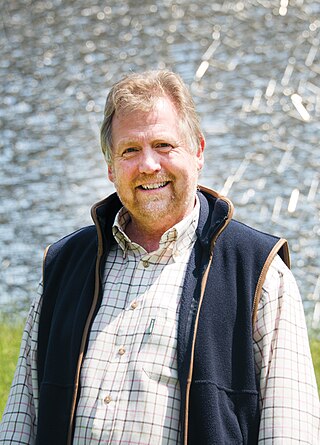
Tony Kirkham MBE VMH is the former Head of Arboretum, Gardens & Horticulture Services, Royal Botanic Gardens, Kew.
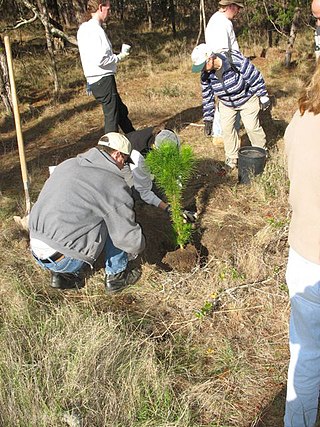
The Monterey County reforestation refers to efforts in Monterey County, California, to preserve the county's pine forests and urban environment. This one county boasts the native Monterey Pine ecosystem; one of the rarest forest ecosystems in the world. Only a few thousand acres of these endemic trees exist in four locations along the Pacific Ocean on the Central Coast of California. The city of Monterey itself maintains more than 19,000 trees in parks and along streets, as well as about 300 acres (1.2 km2) of Monterey Pine forests.
The Davey Tree Expert Company, also known as Davey Tree, is a North American employee-owned corporation. The company's main services are research driven tree services, grounds maintenance and environmental consulting services for residential, utility, commercial and environmental partners in the United States and Canada. Davey has employees throughout the United States and Canada.
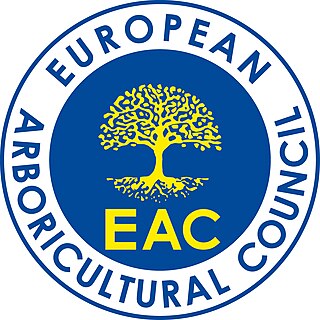
The European Arboricultural Council (EAC) based in Bad Honnef, Germany is a forum where delegates from a wide range of arboricultural organizations throughout Europe meet. The goal of the EAC is to elevate the status and to raise the professional level of competence within arboriculture. This objective is carried out by liaising on matters ranging from research and education to successful tree establishment and the improvement of safe working practices.
The Master Arborist or Board Certified Master Arborist credential identifies professional arborists who have attained the highest level of arboriculture offered by the International Society of Arboriculture (ISA) and one of the two top levels in the field. There are several paths to the Board Certified Master Arborist, but typically on average each has been an ISA Certified Arborist a minimum of three to five years before qualifying for the exam. The certification began as a result of the need to distinguish the top few arborists and allow others to identify those with superior credentials. The ISA added specialty certifications of Utility Specialist, for those maintaining vegetation around electric utility wires, Municipal Specialist, for those with additional experience managing public urban trees.
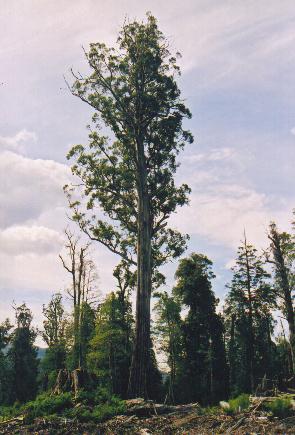
Trees can live for a long time but eventually die, either from natural causes or killed by man. Ill-health of trees can be diagnosed, and early treatment, pruning or felling to prevent the spread may result in timber stocks and amenity trees being saved. Tree owners and Arborists/arboriculturists need to be aware of the risk posed by hazardous trees. Construction projects sometimes avoidably damage trees.
The Arboricultural Association is the largest body in the UK for the amenity tree care professional (arboriculturalists).

A tree fork is a bifurcation in the trunk of a tree giving rise to two roughly equal diameter branches. These forks are a common feature of tree crowns. The wood grain orientation at the top of a tree fork is such that the wood's grain pattern most often interlocks to provide sufficient mechanical support. A common "malformation" of a tree fork is where bark has formed within the join, often caused by natural bracing occurring higher up in the crown of the tree, and these bark-included junctions often have a heightened risk of failure, especially when bracing branches are pruned out or are shaded out from the tree's crown.
A branch attachment is where a branch is attached to the trunk of a tree. Three types of branch attachment are recognized due to differences in the anatomical position of buds that form them. Two key components contribute to the mechanical strength and toughness of the attachment: interlocking wood grain at the top of the attachment and an embedded knot that often lies within the attachment. A common malformation of a branch attachment is the inclusion of bark within the join, which can weaken the attachment.
ANSI A300 is the tree care industry standard of care in the USA. It was developed by Tree Care Industry Association and maintained by consensus of various industry stakeholders through periodically reviewing and updating the guidelines. The standard is divided into ten parts:

